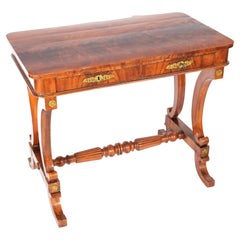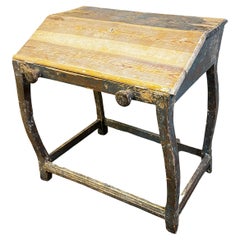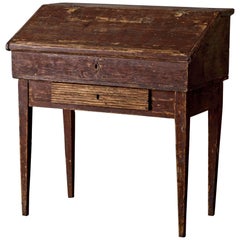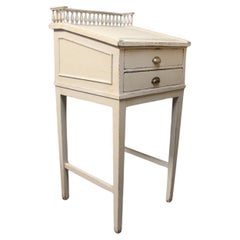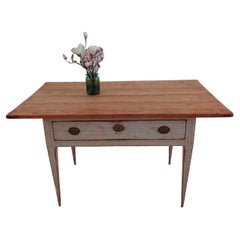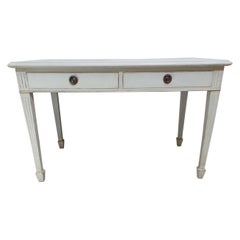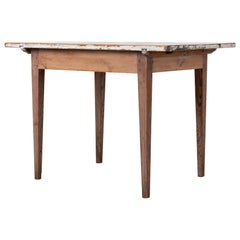Gustavian Writing Desk
Antique Late 18th Century Scandinavian Gustavian Desks and Writing Tables
Brass
Antique 18th Century Swedish Gustavian Desks
Brass
Antique Mid-19th Century Swedish Gustavian Desks and Writing Tables
Brass
Antique 19th Century Swedish Gustavian Secretaires
Wood, Pine, Paint
Antique Late 18th Century Swedish Gustavian Desks
Wood
Antique 1840s Danish Gustavian Desks and Writing Tables
Wood
Antique Early 19th Century Swedish Gustavian Desks and Writing Tables
Pine
Vintage 1950s Swedish Gustavian Desks and Writing Tables
Wood
Antique Late 18th Century Swedish Gustavian Desks and Writing Tables
Pine
Antique 1880s Swedish Gustavian Desks and Writing Tables
Pine
Vintage 1940s Swedish Gustavian Desks and Writing Tables
Wood
Antique 1860s Desks and Writing Tables
Wood
Antique Early 19th Century Swedish Gustavian Desks and Writing Tables
Pine
Antique 19th Century Swedish Gustavian Desks and Writing Tables
Wood
Antique Early 19th Century Swedish Gustavian Desks and Writing Tables
Wood, Paint
Antique Early 19th Century Swedish Gustavian Desks and Writing Tables
Pine
Antique Early 19th Century Swedish Gustavian Desks and Writing Tables
Pine
Antique Early 19th Century Swedish Gustavian Desks and Writing Tables
Pine
Antique 19th Century Swedish Desks and Writing Tables
Wood
Antique Early 1900s Swedish Gustavian Desks and Writing Tables
Pine
Antique Early 19th Century Swedish Gustavian Desks and Writing Tables
Pine
Antique Mid-19th Century Swedish Gustavian Desks and Writing Tables
Pine, Paint
Antique Early 19th Century Swedish Gustavian Desks and Writing Tables
Pine
Antique 19th Century French Neoclassical Desks and Writing Tables
Brass
Vintage 1940s Swedish Gustavian Desks and Writing Tables
Wood
20th Century Swedish Gustavian Desks and Writing Tables
Pine
Antique 19th Century Swedish Gustavian Desks and Writing Tables
Pine
Antique 1890s Swedish Gustavian Desks and Writing Tables
Wood
Antique 19th Century Swedish Desks and Writing Tables
Wood
Antique 19th Century Swedish Desks and Writing Tables
Wood
Antique 19th Century Swedish Gustavian Desks and Writing Tables
Wood, Paint
Antique Late 18th Century Swedish Gustavian Desks and Writing Tables
Bentwood
21st Century and Contemporary English Gustavian Desks and Writing Tables
Pine
Early 20th Century Swedish Gustavian Desks and Writing Tables
Pine
Antique 19th Century Swedish Gustavian Secretaires
Pine
Antique 19th Century American Gustavian Desks
Wood
Antique Mid-19th Century Swedish Gustavian Desks
Birch
Antique Early 19th Century Swedish Gustavian Secretaires
Brass
Antique Mid-19th Century Swedish Gustavian Tables
Pine
Antique Mid-19th Century Swedish Gustavian Tables
Pine
Antique Mid-19th Century Swedish Gustavian Decorative Boxes
Pine, Paint
Antique Late 19th Century Swedish Gustavian Secretaires
Bronze
Antique 19th Century Swedish Gustavian Dining Room Tables
Paint
Antique Late 18th Century Swedish Gustavian Secretaires
Wood
Antique 1790s Swedish Gustavian Desks and Writing Tables
Mahogany
Antique 19th Century Swedish Gustavian Desks and Writing Tables
Antique Late 19th Century Swedish Gustavian Desks and Writing Tables
Marble
Antique 19th Century Swedish Desks and Writing Tables
Pine
Antique Late 18th Century Swedish Gustavian Desks and Writing Tables
Wood, Pine
Antique Late 18th Century Swedish Desks and Writing Tables
Pine
Antique 19th Century German Gustavian Desks and Writing Tables
Antique Mid-19th Century Swedish Gustavian Desks
Wood
Antique 19th Century Swedish Desks
Paint
Antique Late 19th Century Swedish Gustavian Secretaires
Wood
Antique 19th Century Swedish Gustavian Commodes and Chests of Drawers
Cherry
Antique Late 19th Century Swedish Gustavian Secretaires
Brass
Antique Early 1800s Swedish Gustavian Desks and Writing Tables
Wood
- 1
Gustavian Writing Desk For Sale on 1stDibs
How Much is a Gustavian Writing Desk?
A Close Look at Gustavian Furniture
With clean lines and muted colors, antique Gustavian furniture is understated and elegant. It represents a more restrained version of the transition from Rococo to neoclassicism that was happening in France under Louis XVI. The style developed under Swedish King Gustav III, who reigned from 1771 until his assassination in 1792, and his son Gustav IV, who ruled until 1809. Although Gustavian furniture is mostly used to refer to pale painted cabinets, commodes, armchairs and other items, it involved a range of influences.
Gustavian-style furniture was inspired by discoveries at Pompeii and Herculaneum as well as the grandeur of European palaces like Versailles, with local softwoods such as pine and birch. There was also an emphasis on natural light; crystal chandeliers and large mirrors played a role in radiating the fleeting daylight of winter, giving it a distinctive aesthetic.
Where earlier furniture was curvy and florid, this new era was more architectural, with tapered and fluted legs and rectangular and oval shapes. Luminous gilt contrasted with the palette of soft blues on upholstery and painted surfaces. Leading furniture builders included Gottlieb Iwersson, Louis Masreliez and Erik Öhrmark. The latter, a French-born Swedish decorator, designed the Sulla chair, a seat that was demonstrative of technical skill and precise craftsmanship and drew on Greek klismos chairs. Masreliez’s Sulla chair was made by Öhrmark and featured decorative ornamentation produced by Jean-Baptiste Masreliez, Louis’s younger brother.
While the wealthy had furniture carved with neoclassical details like scallops and rosettes, more affordable options were adorned with faux finishes that mimicked marble and stenciled patterns. The simple elegance of Gustavian furniture would have a long impact on Swedish design, informing the 20th-century appreciation for function and form. In the 1950s, IKEA mass-produced copies of a Gustavian commode designed by cabinetmaker Georg Haupt, who created pieces for the Royal Palace, making the furniture a fixture of everyday Swedish life.
Find a collection of antique Gustavian seating, tables, decorative objects and other furniture on 1stDibs.
Finding the Right Desks-writing-tables for You
Choosing the perfect writing desk or writing table is a profoundly personal journey, one that people have been embarking upon for centuries.
Queen Atossa of Persia, from her writing table circa 500 B.C., is said to have been the originator of the art of handwritten letters. Hers was reportedly the first in a long and colorful history of penned correspondence that grew in popularity alongside literacy. The demand for suitable writing desks, which would serve the composer of the letters as well as ensure the comfort of the recipient naturally followed, and the design of these necessary furnishings has evolved throughout history.
Once people began to seek freedom from the outwardly ornate styles of the walnut and rosewood writing desks and drafting tables introduced in the name of Queen Victoria and King Louis XV, radical shifts occurred, such as those that materialized during the Art Nouveau period, when designers longed to produce furniture inspired by the natural world’s beauty. A prime example is the work of the famous late-19th-century Spanish architect Antoni Gaudí — his rolltop desk featured deep side drawers and was adorned with carved motifs that paid tribute to nature. Gaudí regularly combined structural precision with decorative elements, creating beautiful pieces of furniture in wood and metal.
Soon afterward, preferences for sleek, geometric, stylized forms in furniture that saw an emphasis on natural wood grains and traditional craftsmanship took hold. Today, Art Deco desks are still favored by designers who seek to infuse interiors with an air of luxury. One of the most prominent figures of the Art Deco movement was French decorator and furniture designer Émile-Jacques Ruhlmann. With his use of neoclassical motifs as well as expensive and exotic materials such as imported dark woods and inlays of precious metals for his writing desks, Ruhlmann came to symbolize good taste and modernity.
The rise in appreciation for Scandinavian modernism continues to influence the design of contemporary writing desks. It employs the “no fuss” or “less is more” approach to creating a tasteful, sophisticated space. Sweden’s master cabinetmaker Bruno Mathsson created gallery-worthy designs that are as functional as they are beautiful. Finnish architect Alvar Aalto never viewed himself as an artist, but, like Mathsson, his furniture designs reflected a fondness for organic materials and a humanistic approach. Danish designers such as Hans Wegner introduced elegant shapes and lines to mid-century desks and writing tables, often working in oak and solid teak.
From vintage desks to contemporary styles, 1stDibs offers a broad spectrum of choices for conducting all personal and business writing and reading activities.
- What is a writing desk?1 Answer1stDibs ExpertSeptember 25, 2019
A writing desk may refer to a desk with a top, often sloping, for writing on or to a portable case with compartments to hold writing materials and a surface for writing.
- 1stDibs ExpertOctober 12, 2021A small writing table is also called a davenport table or davenport desk. They normally feature a sloped or inclined top attached with hinges to the back of the table. On 1stDibs, find a variety of antique and vintage davenport desks.
- 1stDibs ExpertOctober 19, 2021A writing desk with drawers is also called a secretary. It is a desk with drawers, one of which can be pushed out and the front of the desk lowered to create a flat writing surface. These writing desks have been made in a variety of styles over the years. Shop for a variety of writing tables with drawers on 1stDibs.
- 1stDibs ExpertJune 15, 2023What an old-fashioned writing desk is called varies by design. Pieces with drop-down fronts are secretary desks (these are typically made of two parts: a chest of drawers on the bottom and a hutch or cupboard with shelves on the top), while ones that rest on two pillars, cabinets or bookcases are pedestal desks. A desk with a small writing surface positioned in front of drawers and cubbies is a bureau à gradin. On 1stDibs, shop a selection of desks.
- 1stDibs ExpertMarch 3, 2023In French, the term for a writing desk that often featured a drop-down writing surface is secretaire. This type of desk is called a secretary desk in English. Simply put, a secretary desk is a multifunctional piece of furniture with a hinged writing surface that folds open or drops down. When the leaf is folded out, small inner storage compartments, which are called pigeonholes, cubbies, recesses or drawers, are revealed. On 1stDibs, shop antique secretary desks from some of the world's top sellers.


